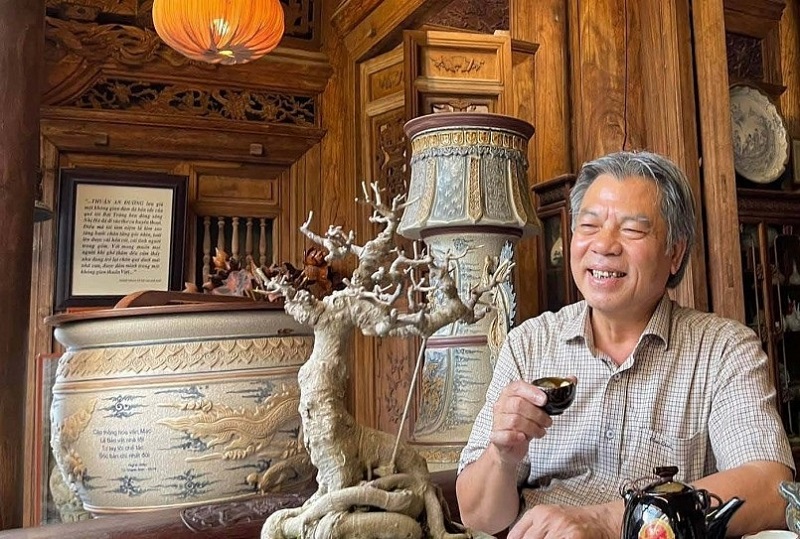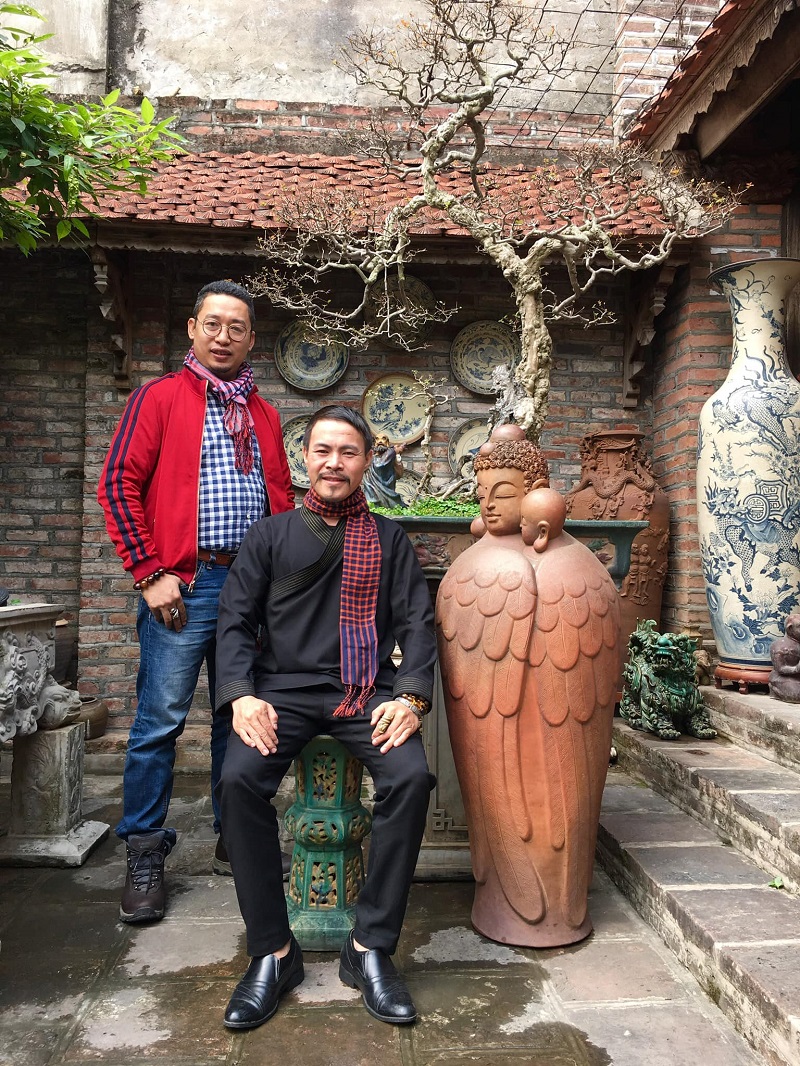Ceramist To Thanh Son: Bat Trang pottery retains national soul
Bat Trang pottery craftsman, has been devoting his whole life to preserving the quintessence of thousand-year-old pottery on the outskirts of Hanoi.
Pottery craftsman To Thanh Son greeted visitors to his workshop called Thuan An Duong in Bat Trang pottery village, Gia Lam District, with a poem he wrote about the thousand-year-old craft on the gate:
“A whole fiery life
Millions of works made
Hands covered with clay
All for this career”
The veteran potter talks with local media about the quintessential craft, Bat Trang pottery artists' creativity, and the traditional craft village market.
| The renowned pottery craftsman, To Thanh Son, is from Bat Trang Pottery Village of Gia Lam District in Hanoi. Photo: Thuong hieu & San pham |
You are the one who is said to get the whole universe into a small basin. Does such a piece of work require a whole process of gaining experience?
Since its birth, ceramics have been among the most loved decorative art products. However, these wonderful works require a blend of function, art, earth, water, and skilled hands.
To my mind, a good ceramist needs not only passion and enthusiasm but also skilled hands and an understanding of the national culture. We are called ‘bluebloods’. I've been helping my parents make ceramics since I was little, not to mention that I’m almost 70 now. So, the craft naturally came into my life.
After completing my military service in the early 1980s, I decided to build a career in the craft handed down by our forefathers. I gained experience from the masters in the village: some in shaping, some in enameling, others in coloring - along with the mysterious heat-related coloring in the kiln. But it was not easy for young, inexperienced people like me to face the market and do business during the subsidy period.
Then, I suddenly remembered the words of my friend and teacher-painter, Prof. Tran Khanh Chuong, that “For ceramics to become sustainable and develop, it must be promoted based on traditional ceramics.” This advice put me on the right track.
| Artisan To Thanh Son (second from left) greeted visitors to his workshop in Bat Trang Pottery Village. Photo: Cao Thanh Son |
In which direction have you and Bat Trang artisans developed traditional ceramics?
As a traditional craft village, it must develop based on traditional values and put quality first. The terracotta and ceramics of Bat Trang are truly “white, clear, thin and round” - not inferior to Jiangxi ceramics in China. Our tea sets, flower vases, and many other products have a traditional look and feel. Meanwhile, the enamel color and patterns, such as bamboo clusters, taro clusters, or dragonflies, are also very vibrant yet well suited to modern tastes.
I’m proud that Bat Trang ceramics are unique in their elegant and delicate beauty. The typical Bat Trang clay core is a mixture of the Red River’s sand and alluvium. The glaze is fired at a relatively high temperature - from 1,250 to 1,320 degrees Celsius - to produce a deep color characteristic of ancient ceramics. The glaze is ash, made by burning rice husk, mixing it with mud and limestone powder in a certain proportion, then finely grinding it. We ceramicists must be meticulous in choosing the clay, kneading, shaping, and refining the enameled patterns for each product.
| A part of the Thuan An Duong Showroom in Bat Trang Village, Hanoi. Photo: Cao Thanh Son |
How do you evaluate the innovation and creativity of other ceramists?
In recent years, Bat Trang ceramics village has witnessed many changes, including the aspirations of non-native artisans, who not only work hard but innovate as well. For example, artisan Nguyen Hung is associated with the noun ‘Hoang Tho Lien Hoa’ of Yellow Clay and Lotus.
After more than 15 years of research based on the traditional ash glaze, Hung introduced a new type using lotus stem ash. This glaze allows for a wider range of colors, helping artisans to control the colors of ceramics like painters.
The wondrous symphony of the lotus and the properties of the modified core - made from the alluvial deposits of the Red River - bring new colors suitable for products bearing the national spirit.
There are many other innovations. I also often remind myself and my students to be creative. Another important thing is that ceramic techniques have also evolved. After decoration, ceramic products are coated with a layer of processed glaze and placed in a kiln for high-temperature baking.
Historically, households in Bat Trang used coal kilns, but due to industrialization and modernization, as well as to reduce environmental pollution, we now use gas kilns. Promoting the craft village in parallel with environmental protection will bring sustainable development, and consumers will favor the products we make more and more.
| The typical pottery products made by artisan To Thanh Son. Photo: Thuong hieu & San pham |
You just said that ceramics always requires creativity. But how should we be creative not to lose the inherent value of Bat Trang ceramics?
The State has many policies to help preserve and promote the traditional cultural values of Bat Trang pottery village. Moreover, international friends visiting Vietnam are especially fond of the products of Bat Trang. They often watch the artisans making ceramics and also love to do the job themselves for a while.
After tours, tourists often buy products here as gifts for friends and family. In this way, the Bat Trang pottery brand is known to many people and promotes Vietnamese handicraft villages' values and identity.
Creativity means that each potter needs to experiment and create various designs and images but still follow traditional values. What is depicted by each product must belong to Vietnam, bearing the colors and images of the country and Vietnamese people.
I’m also happy and proud to talk about the handicraft village in my hometown and display ceramic products at important events. In this way, many will understand that Bat Trang ceramics has evolved but still retains the national soul and attention to detail.
| Visitors to Thuan An Duong Showroom enjoy taking photos with To Thanh Son's artwork. Photo: Cao Thanh Son |
On the occasion of the millennium anniversary of Thang Long - Hanoi in 2010, you made a big-bellied jar named 'In the Shape of a Lotus Bud’. Is this work popular because of its historical and cultural values?
“Dedicating an elegant ceramic in the shape of a lotus bud
Fast, glossy enamel reflects magical light
A thousand years of deposition today shines
A majestic witness of history without words..."
The big-bellied jar looks elegant, like a lotus, and its entire surface is engraved with a circular relief depicting the image of King Ly Cong Uan reading ‘Chieu Doi Do’ or the Edict on the Transfer of the Capital to Thang Long. This is one of the works I love and cherish in my career.
Bat Trang pottery village has changed a lot, and the products are more diverse now, but the core is still the traditions. We shouldn’t think ceramic products must be updated with only modern features to have a modern feel. That’s not true! The more life develops, the more valuable what goes back to the roots and traditions. This is the national identity.
Thank you for this conversation!
















